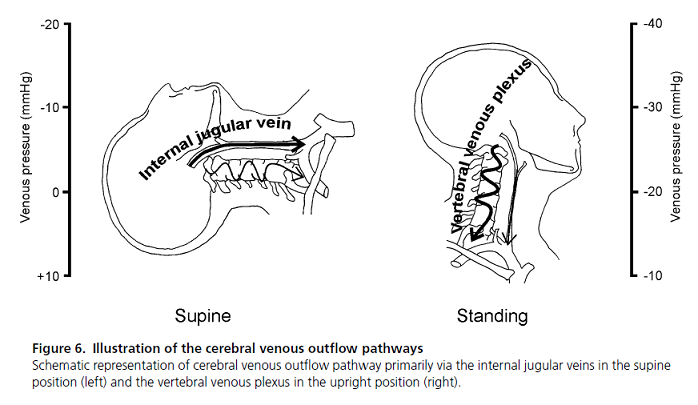Page 1 of 1
stats on IJVs
Posted: Tue Jul 19, 2011 12:15 pm
by Cece
http://www.ijbms.com/anatomy/supra-clav ... ler-study/
The diameters of internal jugular veins on the right and left sides were noted .The mean diameter of the right IJV was 8.7mm and left IJV 8.6mm (Table-3), and the difference is not statistically significant. (p>0.05)
Do those numbers seem accurate or do they seem on the small side?
I had thought the left IJV was commonly smaller but not in this study.
Posted: Tue Jul 19, 2011 5:15 pm
by Cece
http://ajpregu.physiology.org/content/287/4/R911.full
Of more relevance for cerebral blood flow, internal jugular venous pressure at the base of the skull was 9.5 (SD 1.2) mmHg during supine rest, and MAP was between 90 and 95 mmHg (Figs. 1 and 2; Table 1). When the head was elevated ∼25 cm above the level of the heart by raising the bed to 40°, internal jugular venous pressure fell to 0.2 (SD 1.0) mmHg, while MAP was between 90 and 100 mmHg and CVP fell from 7.0 (SD 0.5) to 3.0 (SD 1.0) mmHg. While the subjects were sitting up, spinal fluid pressure was 26 (SD 4) mmHg, corresponding to a pressure of 0.1 (SD 4.1) mmHg at the base of the brain. Cerebral blood flow was maintained in the upright position as jugular venous [62.0 (SD 2.4)%] and frontal lobe oxygen saturation [68.4 (SD 1.1)%] did not change significantly.
The difference in internal jugular venous pressure when lying down as opposed to upright.
Posted: Wed Jul 20, 2011 7:34 am
by Cece
www.medscape.org/viewarticle/522597_3
Schreiber and colleagues[46] also investigated human cerebral venous blood drainage with color-coded duplex ultrasound. In their first study, they reported that total venous blood flow at rest was 766 ± 226 mL/minute in healthy human volunteers in the supine position, with the majority of flow through the internal jugular veins (720 ± 232 mL/minute) and a small amount of flow (47 ± 33mL/ minute) through the vertebral veins.[46] In a later study, they found that 6% of healthy human volunteers had a predominantly nonjugular pattern of cerebral venous drainage when in the supine position.[41]
If nonjugular pattern of cerebral venous drainage can be considered akin to CCSVI, this is nearly identical to Dr. Haacke's findings of 8% of healthy volunteers had CCSVI.
Posted: Wed Jul 20, 2011 7:56 am
by Cece
 http://jp.physoc.org/content/560/1/317.full.pdf
http://jp.physoc.org/content/560/1/317.full.pdf
This article is on the complex side but the image is simple enough.
Posted: Wed Jul 20, 2011 4:04 pm
by 1eye
Cece wrote:www.medscape.org/viewarticle/522597_3
Schreiber and colleagues[46] also investigated human cerebral venous blood drainage with color-coded duplex ultrasound. In their first study, they reported that total venous blood flow at rest was 766 ± 226 mL/minute in healthy human volunteers in the supine position, with the majority of flow through the internal jugular veins (720 ± 232 mL/minute) and a small amount of flow (47 ± 33mL/ minute) through the vertebral veins.[46] In a later study, they found that 6% of healthy human volunteers had a predominantly nonjugular pattern of cerebral venous drainage when in the supine position.[41]
If nonjugular pattern of cerebral venous drainage can be considered akin to CCSVI, this is nearly identical to Dr. Haacke's findings of 8% of healthy volunteers had CCSVI.
Only if the reason they didn't use their jugulars was because they couldn't, and what's more, what is really the problem with a non-jugular drainage when supine? How healthy is healthy? How insufficient is insufficient? How can you be both?
